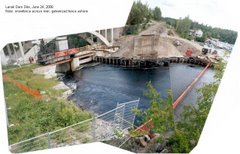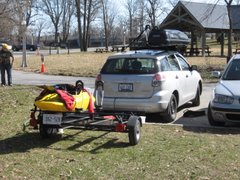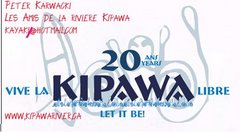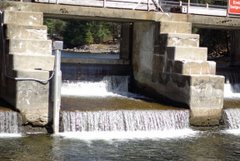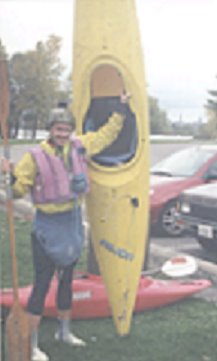According to a federal report obtained by Le Devoir and other information obtained by environmental groups:
•a new environmental assessment bill to replace CEAA would be introduced into the House of Commons in March or April;
•all four of the so-called triggers for environmental assessment (regulatory approval, property transfer, funding, federally managed projects) would be eliminated;
•a short list of categories of projects subject to federal environmental assessment would be set out in a schedule to the new bill;
•environmental assessments would be carried out by the Canadian Environmental Assessment Agency, or by the National Energy Board or Canadian Nuclear Safety Commission (for pipeline and nuclear projects respectively);
•Environment Canada, Fisheries and Oceans Canada and other federal agencies would no longer have environmental assessment responsibilities; and
•provincial assessments could substitute for those federal assessments that are required.
“Our knowledge of the contents of the proposed legislation is incomplete,” said SteveHazell of the Sierra Club.
“For example, we don’t know if the government plans to eliminate public hearings for large projects and funding for public participation in environmental assessments. We don’t know whether the government plans to change constitutionally entrenched environmental assessment provisions of aboriginal claims laws, or drop requirements to assess the cumulative effects of projects.“
The Canadian Environmental Assessment Act was enacted by the Conservative government of Brian Mulroney in 1992.
The uncovered federal report does not commit the government to public consultations on the new bill.
Anyone writing to their MP should also include the Opposition critics in their correspondence.
The Environment Critics' role has assumed greater status,they are keen, active, have the ear of their leaders and need to hear from us.
Individual MPs not having environmental responsibilities may not have time.
Linda Duncan is the new NDP Environment Critic
MP, Bruce Hyer, is the deputy critic with particular responsibility for Water -- important as changes to the Navigable Waters rotection Act that are on the table.
http://www.cbc.ca/technology/story/2009/01/22/environment-ndp.html
http://www.financialpost.com/news/story.html?id=1207155
also
http://www.calgaryherald.com/news/Tories+want+environmental+corners/1206431/story.html
http://thetyee.ca/Blogs/TheHook/Environment/2009/01/22/Leakedmemo/
http://www.theglobeandmail.com/servlet/story/RTGAM.20090122.wPOLenvi0122/BNStory/politics/home
Jamie Kneen
Communications & Outreach Coordinator ofc. (613) 569-3439
MiningWatch Canada cell: (613) 761-2273
250 City Centre Ave., Suite 508 fax: (613) 569-5138
Ottawa, Ontario K1R 6K7 e-mail: jamie@miningwatch.ca
Canada http://www.miningwatch.ca
Skype: jamiekneen
Thursday, January 22, 2009
Tuesday, January 20, 2009
Kipawa River Case typical of Bureaucrats running amok

In § 4.3
From the time of the enforcement of the present transfer according to §12, the government of Quebec will continue an operation mode of the transfered dams that keeps to biological and human usage, to current land use and takes in account the needs of navigation.
In § 9.1, one can read:
"Environmental Assessment of the Site Phase 1, Laniel Dam, municipality of Laniel, district of Mazenod, province of Quebec" prepared by Trow Consulting Engineers Ltd., March 30 2001;"
Was this EA report that used to complete the screening report for the new dam:
- in his Affidavit, Richard Jones said that PWSGC has hired the consultant Jacques Whitford Ltée to characterize the fish habitat and to write the screening report in accordance whith the CEAA.
- Yvon Morin said in his affidavit, that it was the same consultant who concluded, given the proposed mitigation measures, that the new dam will not have significant impact on navigation.
Attached - a letter written by Denis Clermont, Treasurer and Secretary of the MRC of Teminscaming, to the Regional Minister Pierre Corbeil, found in the archives of the gouvernment of Quebec www.bibliotheque.assnat.qc.ca/01/mono/2005/04/806746.pdf
The Tabaret project was well known by the gouvernment of Quebec, well before the conclusion of the agreement to transfer the dam to Quebec from the Federal Government.
SECTION 11
COMPENSATION
11,1 The government of Canada has committed itself to pay to the government of Quebec a sum of FORTY FOUR MILLION HUNDRED TWENTY THOUSAND DOLLARS (44 120 000.00 $) by the time of the transfer scheduled in subsection 12,1 of the present document.
In accordance with the Financial Administration Act (L.R.C. ch F ll), this committment of the government of the Canada to the terms of the present section is conditioned by the necessary credit approval of the Parliament of Canada.
Speaking notes concerning CRN

Speaking Notes:
Yes, all of this information is freely available for you to distribute as best you can.
Doug
As you will see from the attached, the federal government has advancedplans in place to strip navigation rights from thousands of riversacross Canada, and they plan to do this quickly without publicconsultation under the pretext of saving the economy. Please review this material and help any way you can:
1) Distribute this informaiton through your networks.
2) Act and encourage others to act by initiating efforts to informpoliticians at every level that navigation rights and environmental lawsin Canada should not be tinkered with under the guise of helping theeconomy.
3) If you are a member of an organization that wants to be publiclylisted as a supporter of the Canadian Rivers Network, let us know bysending us an email with the name of your organization, and contactinformation for a designated representative.
4) Speak the media about the NWPA issue at whatever level you can,local, regional, proviincial or national.
5) Let us know if you have the name of anyone who is qualified andwilling to speak to the national media on behalf of the Canadian RiversNetwork.
Please let us know if you require any additional information orassistance.
January 19, 2009
The following are a series of speaking notes prepared by the Canadian Rivers Network, that you can use when speaking to people, groups, your municipal, provincial, territorial or federal government representatives, or to the media on the topic of navigation rights in Canada and the move by the Harper government to strip navigation rights from thousands of waterways across Canada by gutting the navigable Waters Protection Act.
WHAT THE CONSERVATIVES WANT TO DO:
The Harper government is poised to erase the historic right of navigation in Canada, a common law right that pre-dates confederation.
In public announcements published in the major media January 12 and 13, 2009, the Harper government stated its intent to gut the Navigable Waters Protection Act as part of its plan to inject billions of dollars into infrastructure programs across the country.
The Harper government says the NWPA is antiquated and they want it out of the way.
HOW THEY PLAN TO GUT THE NWPA:
The Harper government launched a strategy in July of 2006, less than six months after taking office, to strip navigation rights from thousands of waterways across Canada, and eliminate the need for developers to consider impacts on the public right of navigation when building in or near water.
They plan to do this by amending the Navigable Waters Protection Act so that it does not apply on thousands of Canadian waterways.
The Harper government intends to:
- strip the four named works in the NWPA (bridges, dams, booms and causeways) and remove those types of works from automatic assessment for impacts on navigation
- exempt minor works from the provisions of the NWPA
- exempt minor waters from the NWPA
WHY ARE NAVIGATION RIGHTS IMPORTANT:
The public right of navigation in Canada pre-dates confederation. In fact public navigation rights date back to Roman law and are entrenched in some form in the laws of virtually all modern nations.
In 1882, while Sir John A. MacDonald was Prime Minister of Canada, the Canadian parliament enacted one of the first truly national pieces of legislation and entrenched the common law right of public navigation through the Navigable Waters Protection Act (NWPA).
The intent of the NWPA at that time was to ensure that the extensive development taking place on waterways did not unnecessarily or extensively interfere with the long-established public right of navigation.
Protecting the public right of navigation was important in 1882 and it is important today, perhaps even more so.
The NWPA is an old piece of legislation but it is far from irrelevant. In 1990 the Supreme Court of Canada reaffirmed the value and critical importance of protection the public right of navigation in Canada in its Oldman River decision.
Canadian waterways have never in our history been under the level of development pressure that they are today. Developments in and around our waterways are being proposed and occurring at an ever-increasing rate.
If you strip the need to consider the public right of navigation when developing structures on waterways, you eliminate one of the pillars of protection on our natural environment, you put Canadian rivers at risk.
Canada was discovered, explored and developed through the navigation of our waterways. Navigation is an important part of our heritage and an integral part of the heritage of Aboriginal Canadians.
WHAT HARPER IS DOING:
The Harper government is using an international economic crisis as an opportunity to strip Canada’s environmental laws. The government is acting radically. The government is breaching the public trust. Harper does not have a mandate from the Canadian people to gut our environmental laws.
This eagerness to turn a blind eye to the environmental impacts of runaway development will have negative impacts on Canada, our environment, and our international reputation for generations.
WHAT JOHN BAIRD IS SAYING:
Here’s what Transport Minister John Baird said about the NWPA, the law in place to protect the right of Canadians to travel our waterways (National Post, January 12, 2009):
"We have a lot of rules in place to stop bad things from happening…”
Mr. Baird called the NWPA “a huge regulatory burden that can really slow things down."
The government is also talking about “…overhauling the environmental assessment process, which addresses the effect of a project on the surrounding area.”
So the Harper government’s strategy in responding to Canada’s current economic challenge is to:
Save the economy by gutting the environment.
WHAT THE HARPER GOVERNMENT ISN’T TELLING YOU:
Their plan to erase navigation rights in Canada has nothing to do with the current economic situation. The plan to gut the NWPA is part of an overall strategy to remove environmental safeguards in Canadian law.
The current move to gut the NWPA dates is part of a multi-year strategy crafted within the Navigable Waters Protection Program of the Ministry of Transport dating back to July of 2006, less than six months after the Harper government first took office.
This strategy hit the public last May when it became known that the Parliamentary committee for transportation, infrastructure and communities was holding hearings on proposed changes to the NWPA, without consulting anyone with any interest in preserving the public right of navigation in Canada.
That parliamentary committee then rushed a report through in June recommending the changes to the NWPA, the effect of which is to remove navigation rights from thousands of waterways across the country.
WHAT THE HARPER GOVERNMENT WANTS TO DO:
The historic test for navigable in Canada is, if you can paddle a canoe in it, it’s a navigable waterway. There is probably not a more appropriate test in Canadian legal tradition than this “float a canoe” test in the NWPA. It is distinctly Canadian. It’s part of our heritage.
The Harper government wants to eliminate that legal test and exempt thousands of waterways from the NWPA by calling them “minor waters”. Here’s a definition for “minor waters” proposed by Transport Canada in 2007:
Minor Waterways Criteria – Proposed National Criteria
- less than 60 cm depth at high water mark
- less than 3 m wide at high water mark
- channel slope greater than 2 percent
- sinuosity* (bends in the river) greater than 2
- natural obstacle frequency* greater than 3
Sinuosity Ratio = ratio of the length of the centreline of the stream to
length of a straight line connecting the same points along the channel
Natural Obstacle Frequency = number of natural obstructions (see
definitions) along a stream length of 500m (250m upstream, 250m downstream)
The government is also considering eliminating “recreational” navigation from the NWPA and exempting “minor works” from consideration under the NWPA, without saying what minor works are.
These NWPA amendments will effectively eliminate the public right of navigation in Canada.
The Harper government is acting radically. They do no have a mandate to eliminate the fundamental right of all Canadians to access and enjoy our waterways. They do not have a mandate to gut Canada’s environmental laws.
In fact, there is a principle of public trust that our government will protect our rights, not remove them arbitrarily.
This is an issue that affects anyone who access Canadian waterways for any reason. This is an issue that affects all Canadians.
Ottawa seeking to speed up process for works projects
BRIAN LAGHI AND STEVEN CHASE
From Tuesday's Globe and Mail
January 13, 2009 at 4:24 AM EST
OTTAWA — Ottawa is moving to speed up the process for building roads, bridges and other job-rich public-works projects - pledging to slim down excessive environmental requirements and asking provinces to supplement construction that would help native Canadians.
Both issues are expected to be discussed this week when Prime Minister Stephen Harper meets with premiers as well as territorial and native leaders. The measures are being planned for the crucial budget of Jan. 27, when Ottawa will fight economic downturn by running a deep deficit and doling out up to $30-billion in stimulus spending.
The federal government has been consulting widely with the provinces over the past few weeks to find what the bureaucracy has called "shovel-ready" projects that can be started quickly in an effort to soften the downturn's impact.
Two provincial sources have told The Globe and Mail that the provinces want to see Ottawa cut some of the procedures when it comes to environmental assessments that must be done before projects are begun. Often, federal and provincial governments each conduct their own environmental studies before a project can be started. But the desperate need to get the work going has compelled discussion on ways to reduce environmental preparation.
Infrastructure Minister John Baird acknowledged in an interview yesterday that he is looking at removing redundant regulation.
"There's a real hodge-podge of environmental assessment requirements - of overlap and duplication," he told The Globe and Mail. "Many of them are just duplicating what's done at the provincial level."
Federal sources added that they have asked the provinces to supplement work on native reserves with provincial projects. Ottawa has a long list of schools, treatment plants, multipurpose facilities and other projects that could be built on reserves across the country, reducing the huge unemployment rate in those areas.
However, because reserves are on federal land, provinces are reluctant to take part. Nonetheless, Ottawa is asking them to spend money in related areas. For example, if the federal government were to construct a water treatment plant on a reserve, it might ask the provincial government to pay for water lines that are connected to a neighbouring town.
"I think [Finance Minister Jim] Flaherty's worst fear is that we will put a whole bunch of money on the table on Jan. 27 and the provinces can ease off," a federal source said. "There's a real premium on partnership here."
Although premiers such as Ontario's Dalton McGuinty are said to be against the idea, others, including British Columbia's Gordon Campbell and Saskatchewan's Brad Wall, like the notion. Ottawa hopes the latter make their voices heard at this week's meeting.
Mr. Baird said streamlining environmental assessments is one of several changes Ottawa is mulling, adding that rewriting laws is another.
He said, for example, that the Navigable Waters Protection Act as currently written is an example of outdated legislation that can hamper public works.
"We got an earful wherever we went from British Columbia to Nova Scotia on that," he said.
http://www.nationalpost.com/news/canada/story.html?id=1167127
Old Law A Hurdle To New Roads
'Mish-Mash'; Tories eye change to environmental legislation
James Cowan, National Post, With Files From CanWest News Service
Published: Monday, January 12, 2009
A century-old piece of legislation that frequently stalls construction projects will be among the laws the Conservative government will target for revision as it attempts to infuse billions of dollars into Canada's lagging economy.
Faced with a recession, Jim Flaherty, the Finance Minister, likely will announce stimulus measures in the budget on Jan. 27. At the same time, the Conservatives will pursue changes to environmental assessment laws and other regulations that delay infrastructure projects once they receive funding.
"There's a lot we can do -- whether it's statutory, regulatory, processes -- that can speed up getting shovels in the ground," said John Baird, the Minister of Transport, Infrastructure and Communities, in an interview yesterday.
"We have a lot of rules in place to stop bad things from happening, but little in place to facilitate good things."
The federal government is already committed in 2007 to spending $33-billion over seven years on roads, public transit and other infrastructure projects.
Among the laws earmarked for revision is the Navigable Waters Protection Act, which was enacted in 1882 to regulate the construction of dams and bridges and guard marine routes from intrusions by the logging industry.
The law has been revised over the years, but Mr. Baird said its antiquated guidelines fail to distinguish between "the tiniest creek and the bridge between New Brunswick and Prince Edward Island."
"It's a piece of legislation brought in the 1800s with, frankly, little benefit but huge regulatory burden that can really slow things down," he said.
Rodney MacDonald, the Premier of Nova Scotia, and other provincial leaders have raised the need to reassess the act. However, potential caused concern for environmentalists and boaters.
Discussions are also under way about overhauling the environmental assessment process, which addresses the effect of a project on the surrounding area.
Different assessment standards apply to different projects receiving federal funding, Mr. Baird said.
"It's a real mish-mash, hodgepodge."
Mr. Baird intends to meet on Thursday with the mayors of some of Canada's largest cities to ask them to support measures aimed at reducing bureaucratic delays to infrastructure projects.
Michael Ignatieff, the Liberal leader, has called for increased infrastructure spending in the upcoming budget along with support for individuals affected by the economic downturn.
Stephen Harper, the Prime Minister, told reporters last week that the budget will contain a "big, comprehensive" plan to bolster the economy.
"We are in an unprecedented period," he said on Friday. "We are ready to listen to all the suggestions and we are looking at hundreds of possibilities."
Statistics Canada reported on Friday that 34,000 full-time jobs were lost last month, while the United States shed 524,000 jobs.
"Obviously the figures today are troubling," Mr. Harper said.
"Every time a Canadian loses his job this is something that really does preoccupy us. What I think is more troubling are the figures in the United States, which really do indicate the period of difficulty we are entering in terms of the global economy."
Mr. Flaherty has said the Jan. 27 budget will contain a "substantial deficit."
It is expected the Conservatives will commit at least $30-million toward retraining workers who have lost their jobs, boosting consumer spending and other initiatives.
Canadian Rivers Network Gets Rolling

About the CRN:
January 19, 2009
The Canadian Rivers Network (CRN) is a coalition of groups and organizations across Canada working together to:
- Inform Canadians about the value of our waters, rivers, lakes and streams.
- Advocate for the conservation of natural and cultural heritage values associated with Canadian waters, rivers lakes and streams.
- Advocate for the preservation of the ancient right of public navigation on Canadian waterways.
The CRN was formed in June of 2008 in direct response to an initiative of the federal government to amend the Navigable Waters Protection Act (NWPA) and eliminate navigation rights on thousands of waterways across Canada.
In media reports January 12 and 13, 2009, it became clear that this initiative to amend the NWPA and the Canadian Environmental Assessment Act is now part of the federal government’s economic recovery package.
OUR POSITION:
The federal government is acting radically by attempting to gut Canadian laws intended to protect the environment, under the guise of rescuing the economy.
The Harper government does not have a mandate to eliminate the public right of navigation on Canadian waterways, a common law right that predates confederation.
The Harper government does not have a mandate to gut the Canadian Environmental Assessment Act.
For more information on the Canadian Rivers Network, please email us or visit our website.
canrivers@sympatico.ca
www.ispeakforcanadianrivers.ca
Backgrounder:
January 19, 2009
The following detailed background information was prepared by the Canadian Rivers Network for use by organizations and individuals across Canada responding to the current efforts by the federal government to eliminate navigation rights on thousands of waterways through amendments to the Navigable Waters Protection Act.
This background does not paint a very pretty picture of what is occurring.
1) We have a federal government that is attempting to dismantle navigation rights and other environmental regulations in Canada under the pretext of rescuing the economy.
2) We have senior federal public servants who’s job it is to protect the long-standing public right of navigation in Canada, lobbying our government to take those rights away on thousands of waterways across the country.
NOTE: Direct quotes from listed sources are in blue. All of the source documents are available. Our notes are in black.
WHAT IS HAPPENING HERE:
SOURCE: Rod Northey, Fogler-Rubinoff, June 8, 2008, Parliament Hill
http://www.youtube.com/watch?v=Xzf9i8PETss&feature=related
What is happening right now with the Navigable Waters Protection Act is radical. The government is acting radically.
The right of navigation is not an 1882 invention. It is described by all of the courts in the English speaking world as an ancient right derived from Roman law. And most interestingly if you go south of the border or across the ocean where our law derives on the English side, you will find one further addition to the legal terminology…under English law navigation is not just a public right it is a matter of public trust. English law has a public trust doctrine. American law has a public trust doctrine. Their courts hold government to account for breaching public trust. So navigation is not just a mater of saying we have something we are trying to do, it is a matter of throwing back at the very governments that are trying to do something, a reminder that this kind of resource, our waters, are a matter of public trust that they are breaching.
What you want to say about the NWPA as you seek to reopen it is that you want to see a preamble an opening an introduction to that statue that describes the public trust in navigation across Canada. That will tell a story that is in keeping with the law from the south and Great Britain from Roman times that is in keeping with where you are today with the use of rives and where the government is in complete ignorance.
Navigable Waters Protection Act
SOURCE: http://www.tc.gc.ca/quebec/eng/NWP/menu.htm
The Navigable Waters Protection Act (NWPA), Chapter N-22, is a federal law designed to protect the public right of navigation in Canadian waters, as defined by the law, by prohibiting the building, placing or maintaining of any work whatsoever in, on, over, under, through or across any such navigable water, without the authorization of the Minister of Transport Canada.
The expression “navigable water” designates any body of water capable, in its natural state, of being navigated by any type of floating vessel for the purpose of transportation, recreation or commerce and includes a canal and any other body of water created or altered for the benefit of the public, as a result of the waterway assigned for public use.
The Navigable Waterways Protection Act (NWPA), Revised Statutes of Canada, 1985, is one of the oldest pieces of federal legislation. It first became law on May 17, 1882, and was originally intended to protect marine navigation routes by controlling the logging industry and the construction of bridges and dams.
It has undergone a number of changes over the years and its application no0w involves all works in, over, under through or across any navigable waterway in Canada.
Although the scope of the Act has been broadened over the years, its main objective is still to protect the public right to navigation. Today, the Act applies to many different types of projects undertaken on any of the navigable waterways and coastal zones of Canada.
HISTORY OF THE NWPA
May 17, 1882
Navigable Waters Protection Act becomes law in Canada. This was at a time in Canadian history when our waterways were our highways. Development was occurring on waters across the country and the Canadian government acted to ensure that the ancient right of public navigation would be protected for the future.
1883 The four named works were added:
- bridges
- booms
- Dams
- causeways
1886 wharves, docks, piers, and other structures were added
1985 most recent amendments to the act
JURISDICTIONAL HISTORY:
1882 to 1966 Department of Public Works
1966 to 1996 Transport Canada (Canadian Coast Guard)
1996 to 2004 Fisheries and Oceans (Canadian Coast Guard)
2004 jurisdiction transferred to Transport Canada (Marine Safety)
RECENT HISTORY:
June 2005, A Transport Canada Navigable Waters Protection officer says the following about the NWPA when speaking at the AGM of the Ocean Renewable Energy Group at Simon Fraser University:
“Navigable waters” includes any body of water which is capable, in its natural state, of being navigated by floating vessels of any description for the purpose of transportation, recreation or commerce, and includes a canal any other body of water created or altered for public use, as a result of the construction of any work.
“Navigable waters” also includes any waterway where the public right of navigation exists by dedication of the waterway for public purposes or by the public having acquired the right to navigate through long use.
The Canadian Environmental Assessment Act requires the federal government to ensure projects subject to approval under certain other acts undergo an assessment to determine the potential for adverse effects on the environment.
Projects requiring formal approval under the NWPA require environmental assessments.
Key Challenges:
- What is an appropriate mitigation strategy for impacts to navigation?
- Identification of appropriate locations for these ‘works and associated impact to users.
- Balance the need for economic development with the ‘Public Right of Navigation’.
January 2006, federal Conservatives form minority government.
July 2006 Transport Canada staff within the Navigable Waters Protection Program set up a project team and launch a multi-year initiative to gut the NWPA and eliminate navigation rights on thousands of Canadian waterways.
March 2007 A manager from the Navigable Waters Protection Program speaking at an NRCan regulatory efficiency workshop, illustrates very clearly that Transport Canada has changed its tune by describing the NWPA this way:
The Challenges:
The NWPA is a tool of choice for ‘hidden agendas’
- to mediate personal disputes
- to prevent development
- to achieve environmental objectives
This NWP program manager also stated that one of the problems with the NWPA was that clients and opponents had acquired increased knowledge about the act and its requirements related to developments on waterways.
April 2007 David Osbaldeston, the national manager for the Navigable Waters Protection program within Transport Canada, the senior federal public servant who’s job-one is to protect the navigation rights of Canadians, explained for the Transportation Association of Canada how he was going to eliminate navigation rights on waterways across the country, by exempting minor waters from the provisions of the NWPA, using the following definition for “minor waters”:
Proposed National Criteria for Minor Waters
Average Depth at Ordinary High Water < 0.60m
Width of Waterway at Ordinary High Water < 3.0m
Channel slope > 2%
Sinuosity ratio > 2
Natural obstacle frequency > 3
Sinuosity Ratio = ratio of the length of the centre line of the stream to length of a straight line connecting the same points along the channel
Natural Obstacle Frequency = number of natural obstructions (see definitions) along a stream length of 500m (250m upstream, 250m downstream)
It is important to note what Mr. Osbaldeston says here in very specifically describing exactly what waterways would be classified as “minor”, because less than one year later he would stand before the parliamentary committee for Transportation Infrastructure and Communities and assure the elected members of that committee that he had no specific definition in mind for “minor waters” under an amended NWPA.
January 2008 The federal Minister of Transport asks the parliamentary committee for transportation infrastructure and communities (TRAN) to look at the Navigable Waters Protection Act to determine if it could or should be amended.
February 2008 The TRAN committee then began a series of hearings and invited 70 “stakeholder groups” to make presentations on possible changes to the NWPA.
Of those 70 groups invited to speak to the TRAN committee, only one group (the Lake Ontario Waterkeepers) spoke about the value of the public right of navigation and the need to preserve that right.
All of the other of the hand-picked “stakeholders” invited to present to the TRAN committee argued for the elimination of navigation rights in Canada.
No one representing any of the following groups and interests were invited to present to the TRAN committee:
- No tourism groups
- No First Nations people
- No anglers or hunters
- No cottage or outdoor recreation groups or organizations
- No paddling organizations
The presentations to the TRAN committee were led by staff from within Transport Canada and included David Osbaldeston, the national manager for the Navigable Waters Protection Program.
Shirley Anne Scharf, a senior manager with Infrastructure Canada presenting the TRAN committee:
“The way it (the NWPA) is constructed right now—and I believe David Osbaldeston made this point—minor waters are such that I believe if you float a canoe in a body of water it is considered a navigable water. From that point of view, streamlining the act and excluding things of that nature would be very advantageous.”
David Osbaldeston, told the TRAN committee how he views his job as the senior federal public servant responsible for protecting and preserving the public right of navigation in Canada:
"As you can see, there's very little we deny or refuse. I think that's the main thing: if somebody has a need to put something in the water, over the water, under the water, or through the water, and has a valid need to do it, we'll try our utmost to get it done in a safe manner."
The minutes of the TRAN committee are available on-line. The meetings began in February 2008 and ended in early June of 2008.
http://cmte.parl.gc.ca/cmte/CommitteeList.aspx?Lang=1&PARLSES=392&JNT=0&SELID=e21_&COM=13202
From reading these minutes, it is clear that Transport Canada believes the NWPA as an obstacle to that development. It is also clear that the proposed changes to the NWPA would put virtually every river in Canada at risk.
June 2008 The TRAN committee, without consulting in any way with the people, groups and business sectors that would be impacted by the elimination of navigation right sin Canada, submits a report to the Minister of Transport recommending that the NWPA be amended.
September 2008 Proposed amendments to the NWPA are postponed by the fall federal election. In responding to an extensive public outcry over the potential elimination of navigation rights, the federal government insists that the TRAN committee hearings on the NWPA were simply a “preliminary” consultation and that the public will have a full and complete opportunity to comment on any proposed amendments through a public consultation process.
January 2009 The Harper government announces its intent to overhaul the NWPA to ensure that it does not get in the way of projects funded under its economic recovery infrastructure initiative.
John Baird, Minister of Transport, responsible for the Navigable Waters Protection Act:
SOURCE: National Post, January 12, 2009
"There's a lot we can do -- whether it's statutory, regulatory, processes -- that can speed up getting shovels in the ground," said John Baird, the Minister of Transport, Infrastructure and Communities, in an interview yesterday. "We have a lot of rules in place to stop bad things from happening, but little in place to facilitate good things."
Speaking directly to his plans to gut the NWPA and get it out of the way of the government’s infrastructure investment initiative, Minister Baird said:
"It's a piece of legislation brought in the 1800s with, frankly, little benefit but huge regulatory burden that can really slow things down," he said.
SOURCE: Globe and Mail January 13, 2009
John Baird, Minister of Transport, confirms the Harper government’s plan to do away with federal environmental regulations, including the NWPA.
"There's a real hodge-podge of environmental assessment requirements - of overlap and duplication," he told The Globe and Mail. "Many of them are just duplicating what's done at the provincial level."
Briefing Note:
January 19, 2009
Canadian Navigation Rights at Risk
The Harper government is poised to erase the historic right of navigation in Canada, a common law right that pre-dates confederation.
In public announcements published in the major media January 12 and 13, 2009, the Harper government stated its intent to eliminate the Navigable Waters Protection Act (NWPA) as part of its plan to inject billions of dollars into infrastructure programs across the country.
The Harper government says the NWPA is antiquated and they want it out of the way.
WHAT’S WRONG WITH THIS PICTURE?
1) The common law public right of navigation pre-dates confederation, in fact it dates back to Roman law and is entrenched in the legal systems of virtually all modern nations.
2) The public right to navigate waterways in Canada is and important part of our heritage and an integral part of the heritage of Canada’s Aboriginal peoples.
3) Navigation rights are one of the pillars of environmental protection on Canadian waterways. If you take away navigation rights, you put Canadian waters (our lakes and rivers and streams) at risk.
WHAT THE GOVERNMENT IS SAYING:
Here’s what Transport Minister John Baird says about the NWPA, the law in place to protect the right of Canadians to travel our waterways:
It’s a “…huge regulatory burden that can really slow things down," he said.
The government is also talking about “…overhauling the environmental assessment process, which addresses the effect of a project on the surrounding area.”
So the Harper government’s strategy in responding to Canada’s current economic challenge is to:
Save the economy by gutting the environment.
WHAT THE HARPER GOVERNMENT ISN’T TELLING YOU:
Their plan to erase navigation rights in Canada has nothing to do with the current economic situation. The plan to gut the NWPA is part of an overall strategy to remove environmental safeguards in Canadian law.
The current move to gut the NWPA dates is part of a multi-year strategy crafted within the Navigable Waters Protection Program of the Ministry of Transport dating back to the summer of 2006.
This strategy hit the public last May when it became known that the Parliamentary committee for transportation, infrastructure and communities was holding hearings on proposed changes to the NWPA, without consulting anyone with any interest in preserving the public right of navigation in Canada.
That parliamentary committee then rushed a report in June recommending the changes to the NWPA, the effect of which is to remove navigation rights from thousands of waterways across the country.
WHAT THE HARPER GOVERNMENT WANTS TO DO:
As earlier as April of 2007, the people responsible for protecting the right of all Canadians to navigate our waterways, had already crafted NWPA amendments that would eliminate protection of navigation rights on what its calls “minor waters” in Canada.
The historic test for navigable in Canada is, if you can paddle a canoe in it, it’s a navigable waterway. There is probably not a more appropriate test in Canadian legal tradition than this “float a canoe” test in the NWPA. It is distinctly Canadian. It’s part of our heritage.
Here’s what Transport Canada and the Harper government want to do to that Canadian tradition, a proposed definition for “minor waters” dating to 2007:
Minor Waterways Criteria – Proposed National Criteria
- less than 60 cm depth at high water mark
- less than 3 m wide at high water mark
- channel slope greater than 2 percent
- sinuosity* (bends in the river) greater than 2
- natural obstacle frequency* greater than 3
Sinuosity Ratio = ratio of the length of the centreline of the stream to
length of a straight line connecting the same points along the channel
Natural Obstacle Frequency = number of natural obstructions (see
definitions) along a stream length of 500m (250m upstream, 250m downstream)
WHAT YOU CAN DO:
Voice your opposition to the Harper government’s to plan to save the economy by gutting the environment.
Tell your municipal, provincial/territorial and federal representatives that you don’t want the historic right of navigation diminished in Canada. You want it protected for the future.
Visit our website for information on ways that you and your organization can help.
www.ispeakforcanadianrivers.net
Subscribe to:
Comments (Atom)
Useful Links
- Mount Gox - Bitcoin exchange
- Reggie Middleton's Rapier Analysis
- Ontario Rivers Alliance
- Geodesic Dome Construction
- Canadian Disaster Preparedness
- Globe and Mail
- Chris' The Weekly Telegram
- Michael Rupert of CollapseNet
- Max Keiser
- Nicole Foss Blog - the automatic earth
- Peak Moment Discussions
- Scotia Mocatta Bullion Store
- Dimitry Orlov - Peak Moment Discussions
- Jims's ISFCR Blog
- Jenny Right Side Blog
- Scott Sorensen
Alternative Energy Sites I like
The Queen is not amused!

http://www.ispeakforcanadianrivers.ca/
The Ashlu river: it could happen to you

Whitewater Ontario

Working Hard to Protect Canada's Paddling Resources
Whitewater Ontario - Mission Statement
It is Whitewater Ontario’s mission to support the whitewater paddling community through the promotion, development and growth of the sport in its various disciplines.
We accomplish this through the development of events, resources, clubs, and programs for personal and athletic development, regardless of skill level or focus, to ensure a high standard of safety and competency;
We advocate safe and environmentally responsible access and use of Ontario’s rivers.
Whitewater Ontario is the sport governing body in the province, and represents provincial interests within the national body Whitewater Canada and the Canadian Canoe Association
http://www.whitewaterontario.ca/page/mission.asp
Kipawa, Tabaret, and Opemican
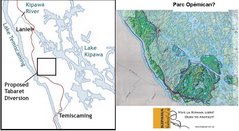
If Hydro Quebec is not actively pursuing Tabaret what is that bite out of Opemican for?
Kipawa Dam: After

Laniel Dam at 2006 Rally
Where is the Kipawa
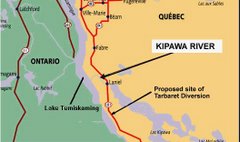
Kipawa flows into lake Temiskamingue, running from Kipawa Lake, under hwy 101 in Quebec
Kipawa Dam

laniel dam at 2004 River Rally
Tabaret is a Bad Idea
About the Kipawa
The best thing paddlers can do to help the cause of the Kipawa:
1. attend the rally and bring others including non paddlers to attend and buy beer and have fun
2. write your MP /MNA and raise the issue and post your objections -1 letter = 200 who didn't write
3. Write Thierry Vandal the CEO of Hydro Quebec strongly opposing the 132 MW standard decrying the use of "diversion" as the most environmentally inappropriate method of power production
4. Write Jean Charest, Premier of Quebec protesting that either the algonquin or the tabaret project will eliminate all other values on the Kipawa River by turning it into a dry gulch.
5. See if you can get other allied groups interested by showing your own interest, ie the Sierra Defense Fund, Earthwild, MEC, and so on.
6. Demand further consultation
7. Currently we are at the point where we need to sway public opinion and raise awareness.
However, if all else fails, don't get mad, simply disrupt, foment, and protest . The Monkey Wrench Gang.
Have you read Edward Abbey?
Important Addresses
CEO,Hydro Québec, 75 boul René Levesque, Montreal, P.Q., H2Z 1A4Caille.andre@hydro.qc.ca
The best thing paddlers can do to help the cause of the Kipawa:
1. attend the rally and bring others including non paddlers to attend and buy beer and have fun
2. write your MP /MNA and raise the issue and post your objections -1 letter = 200 who didn't write
3. Write Thierry Vandal the CEO of Hydro Quebec strongly opposing the 132 MW standard decrying the use of "diversion" as the most environmentally inappropriate method of power production
4. Write Jean Charest, Premier of Quebec protesting that either the algonquin or the tabaret project will eliminate all other values on the Kipawa River by turning it into a dry gulch.
5. See if you can get other allied groups interested by showing your own interest, ie the Sierra Defense Fund, Earthwild, MEC, and so on.
6. Demand further consultation
7. Currently we are at the point where we need to sway public opinion and raise awareness.
However, if all else fails, don't get mad, simply disrupt, foment, and protest . The Monkey Wrench Gang.
Have you read Edward Abbey?
Important Addresses
CEO,Hydro Québec, 75 boul René Levesque, Montreal, P.Q., H2Z 1A4Caille.andre@hydro.qc.ca
Tabaret is a Bad Idea (Part Two)
Les Amis de la Riviere Kipawa is poised to use an application to the Federal Court to issue a Writ of Mandamus to ensure the Minster does what he is supposed to do, protect the public's right to navigate the water control structure at Laniel, Quebec using the Navigable Waters Protection Act. (see http://www.kipawariver.ca/)
In the now gutted Navigable Waters Protection Act lay the means by which the Minister of Transport could keep the public right of passage down our great Canadian Heritage, our rivers and streams which are threatened especially by resource corporations and power brokers such as Hydro Quebec.
These powerful entities continue to petition that 'this' river or 'that' stream is not navigable and therefore not protectable.
I don't say that dams and bridges should not be built, only that if they are, historical navigation rights should be considered and preserved by making reasonable accommodations for recreational boaters.
It is the Minister of Transport, in exercising the right to allow or disallow work on or over a navigable waterway is what keeps boats and recreational boaters plying our waterways.
To many recent cases launched in the Federal Court concerning the Navigable Waters Protection Act, most recently the case of the Humber Environment Group of Cornerbrook Newfoundland versus the Cornerbrook Pulp and Paper Company indicates that the important oversight is not being faithfully performed. Have we really come to the point now where we must say "such and such a stream is one foot deep, possessing so many cubic feet per second flow and so on?" The answer to this is... YES!
The honourable Mr. Justice John A. O'Keefe, ruled that it had not been shown that the river was navigable. How convenient was that to the Minister? But either the Minister of Transport acts to protect our rivers and streams as a public right or he does not and that means rivers and streams currently enjoyed by kayakers and canoists.
Enough of the cheating, and double-talk. Canadians! our rivers and streams are our own, lets urge the Minister of Transport and the our government to protect them.
Peter Karwacki
In the now gutted Navigable Waters Protection Act lay the means by which the Minister of Transport could keep the public right of passage down our great Canadian Heritage, our rivers and streams which are threatened especially by resource corporations and power brokers such as Hydro Quebec.
These powerful entities continue to petition that 'this' river or 'that' stream is not navigable and therefore not protectable.
I don't say that dams and bridges should not be built, only that if they are, historical navigation rights should be considered and preserved by making reasonable accommodations for recreational boaters.
It is the Minister of Transport, in exercising the right to allow or disallow work on or over a navigable waterway is what keeps boats and recreational boaters plying our waterways.
To many recent cases launched in the Federal Court concerning the Navigable Waters Protection Act, most recently the case of the Humber Environment Group of Cornerbrook Newfoundland versus the Cornerbrook Pulp and Paper Company indicates that the important oversight is not being faithfully performed. Have we really come to the point now where we must say "such and such a stream is one foot deep, possessing so many cubic feet per second flow and so on?" The answer to this is... YES!
The honourable Mr. Justice John A. O'Keefe, ruled that it had not been shown that the river was navigable. How convenient was that to the Minister? But either the Minister of Transport acts to protect our rivers and streams as a public right or he does not and that means rivers and streams currently enjoyed by kayakers and canoists.
Enough of the cheating, and double-talk. Canadians! our rivers and streams are our own, lets urge the Minister of Transport and the our government to protect them.
Peter Karwacki
Tabaret is a Bad Idea (Part Three)
10 Reasons WhyTabaret is a Bad Idea1) Tabaret is too big. The station is designed to useevery drop of water available in the Kipawawatershed, but will run at only 44 percent capacity.We believe the Tabaret station is designed to usewater diverted from the Dumoine River into theKipawa watershed in the future.
2) The Tabaret project will eliminate the aquaticecosystem of the Kipawa River.The Tabaret project plan involves the diversion of a16-km section of the Kipawa River from its naturalstreambed into a new man-made outflow from LakeKipawa.
3) Tabaret will leave a large industrial footprint on thelandscape that will impact existing tourismoperations and eliminate future tourism potential.
4) The Tabaret project is an aggressive single-purposedevelopment, designed to maximize powergeneration at the expense of all other uses.
5) River-diversion, such as the Tabaret project, takinglarge amounts of water out of a river’s naturalstreambed and moving it to another place, is verydestructive to the natural environment.
6) The Kipawa River has been designated a protectedgreenspace in the region with severe limitations ondevelopment. This designation recognizes theecological, historical and natural heritage value ofthe river and the importance of protecting it.Tabaret will eliminate that value.
7) If necessary, there are other, smarter and morereasonable options for producing hydro power onthe Kipawa watershed. It is possible to build a lowimpactgenerating station on the Kipawa river, andmanage it as a “run-of-the-river” station, makinguse of natural flows while maintaining other values,with minimal impact on the environment.
8) The Kipawa watershed is a rich natural resource forthe Temiscaming Region, resonably close to largeurban areas, with huge untapped potential fortourism and recreation development in the future.Tabaret will severely reduce this potential.
9) Tabaret provides zero long-term economic benefitfor the region through employment. The plan is forthe station to be completely automated andremotely operated.
10) The Kipawa River is 12,000 years old. The riverwas here thousands of years before any peoplecame to the region. The Tabaret project will change all that.
Problems on a local River?
- There is more to do as well but you have to do your research and above all, don't give up.
- IN the meantime prepared a document itemizing the history of navigation of this spot and its recreational value. Use the Kipawa river history of navigation as a guide: see www.kipawariver.ca
- Under the Ministry of Environment guidelines you have a set period of time to petition the change under the environmental bill of rights, you may have limited time to take this action. But it involves going to court for a judicial review of the decision.
- 4. contact the ministry of natural resources officials and do the same thing.
- 3. contact the ministry of the environment and determine if they approved the project
- 2. determine if the dam was a legal dam, approved under the navigable waters protection act.
- 1. research the decision and timing of it to determine if an environmental assessment was done.
Minden Ontario
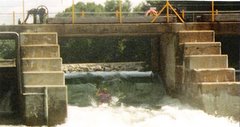
Gull River Water control at Horseshoe lake
A History of Navigation on the Kipawa River
Prior to the environmental assessment there was no signage at the Laniel Dam
T-Shirts Area: These are available now!

Send $25 and a stamped self addressed envelop for the Tshirt, and for the bumper sticker, a stamped and self addressed envelope with $5.00 for the bumper sticker to Les Amis de la rivière Kipawa, 80 Ontario St., Ottawa, Ontario, K1K 1K9 or click the link To purchase a Les Amis "T" contact Doug with the following information: Number of shirts:Sizes: Ship to Address: Method of Payment: cash, cheque and paypal, Shipto address:
Bumper Stickers Now Available

Get your bumper sticker and show your support for the Kipawa Legal Fund ! - send $5.00 in a Stamped, self addressed envelope to: Peter Karwacki Box 39111, Ottawa, Ontario, Canada, K1H 7X0

